instrument panel FORD C MAX HYBRID 2015 2.G Owners Manual
[x] Cancel search | Manufacturer: FORD, Model Year: 2015, Model line: C MAX HYBRID, Model: FORD C MAX HYBRID 2015 2.GPages: 455, PDF Size: 5.94 MB
Page 7 of 455
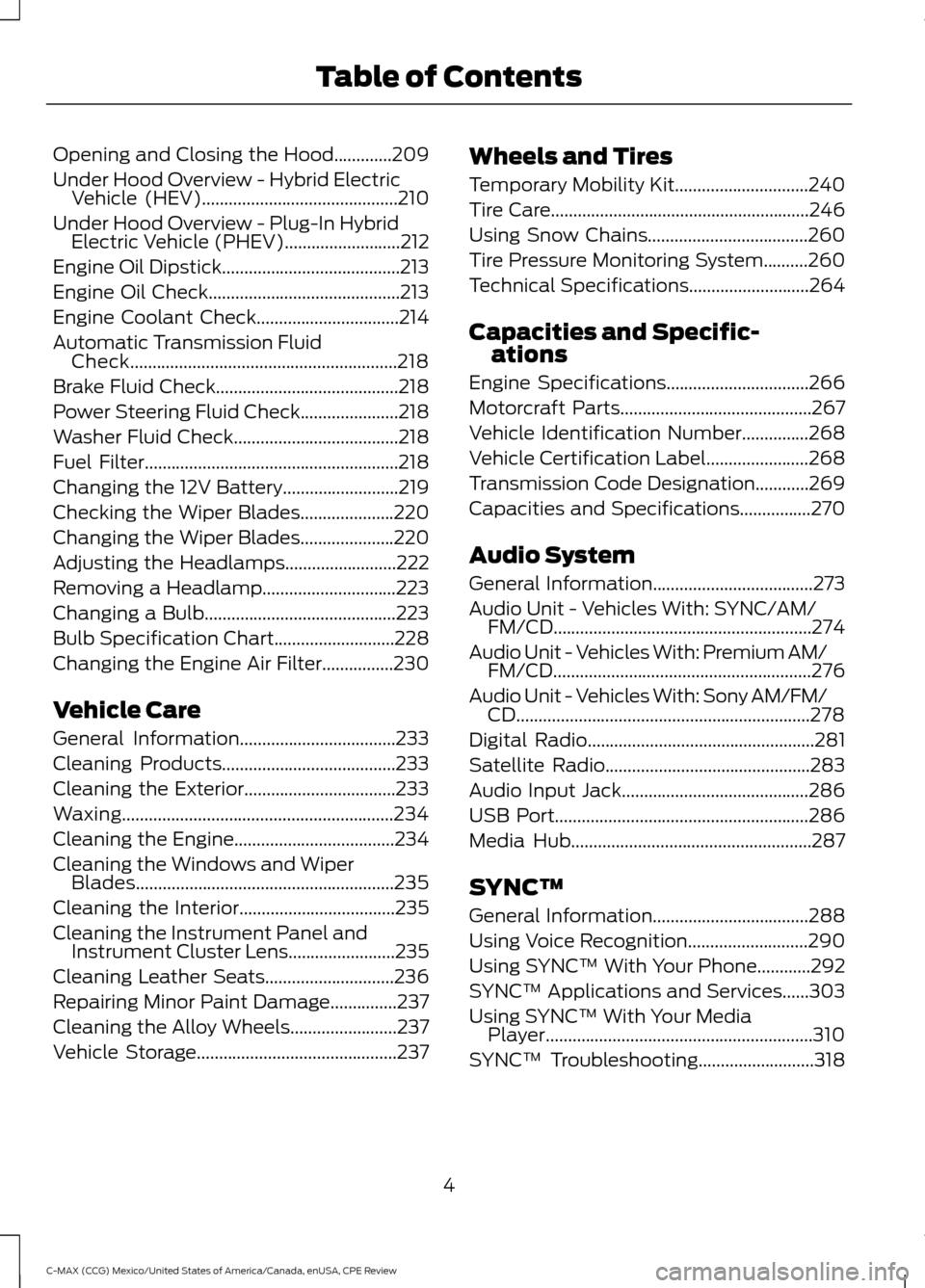
Opening and Closing the Hood.............209
Under Hood Overview - Hybrid Electric
Vehicle (HEV)............................................210
Under Hood Overview -
Plug-In Hybrid
Electric Vehicle (PHEV)..........................212
Engine Oil Dipstick........................................213
Engine Oil Check...........................................213
Engine Coolant Check
................................214
Automatic Transmission Fluid Check............................................................218
Brake Fluid Check.........................................218
Power Steering Fluid Check......................218
Washer Fluid Check
.....................................218
Fuel Filter.........................................................218
Changing the 12V Battery..........................219
Checking the Wiper Blades.....................220
Changing the Wiper Blades.....................220
Adjusting the Headlamps
.........................222
Removing a Headlamp..............................223
Changing a Bulb...........................................223
Bulb Specification Chart...........................228
Changing the Engine Air Filter................230
Vehicle Care
General Information
...................................233
Cleaning Products.......................................233
Cleaning the Exterior..................................233
Waxing.............................................................234
Cleaning the Engine....................................234
Cleaning the Windows and Wiper Blades..........................................................235
Cleaning the Interior
...................................235
Cleaning the Instrument Panel and Instrument Cluster Lens........................235
Cleaning Leather Seats.............................236
Repairing Minor Paint Damage...............237
Cleaning the Alloy Wheels
........................237
Vehicle Storage.............................................237 Wheels and Tires
Temporary Mobility Kit..............................240
Tire Care
..........................................................246
Using Snow Chains....................................260
Tire Pressure Monitoring System..........260
Technical Specifications
...........................264
Capacities and Specific- ations
Engine Specifications................................266
Motorcraft Parts...........................................267
Vehicle Identification Number
...............268
Vehicle Certification Label.......................268
Transmission Code Designation
............269
Capacities and Specifications................270
Audio System
General Information....................................273
Audio Unit -
Vehicles With: SYNC/AM/
FM/CD..........................................................274
Audio Unit - Vehicles With: Premium AM/ FM/
CD..........................................................276
Audio Unit - Vehicles With: Sony AM/FM/ CD..................................................................278
Digital Radio
...................................................281
Satellite Radio..............................................283
Audio Input Jack..........................................286
USB Port
.........................................................286
Media Hub
......................................................287
SYNC™
General Information
...................................288
Using Voice Recognition...........................290
Using SYNC™ With Your Phone............292
SYNC™ Applications and Services......303
Using SYNC™ With Your Media Player............................................................310
SYNC™ Troubleshooting..........................318
4
C-MAX (CCG) Mexico/United States of America/Canada, enUSA, CPE Review Table of Contents
Page 39 of 455
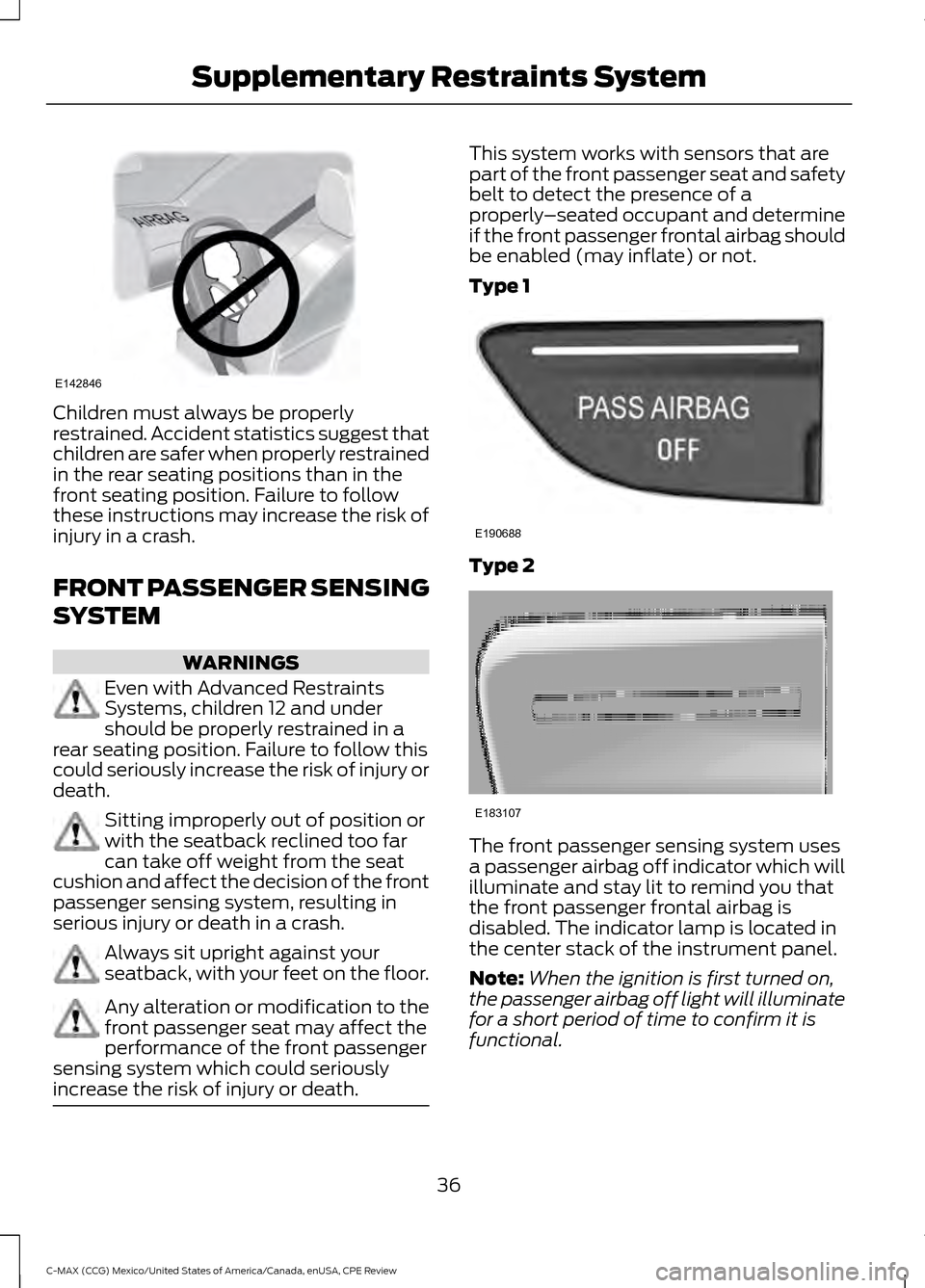
Children must always be properly
restrained. Accident statistics suggest that
children are safer when properly restrained
in the rear seating positions than in the
front seating position. Failure to follow
these instructions may increase the risk of
injury in a crash.
FRONT PASSENGER SENSING
SYSTEM
WARNINGS
Even with Advanced Restraints
Systems, children 12 and under
should be properly restrained in a
rear seating position. Failure to follow this
could seriously increase the risk of injury or
death. Sitting improperly out of position or
with the seatback reclined too far
can take off weight from the seat
cushion and affect the decision of the front
passenger sensing system, resulting in
serious injury or death in a crash. Always sit upright against your
seatback, with your feet on the floor.
Any alteration or modification to the
front passenger seat may affect the
performance of the front passenger
sensing system which could seriously
increase the risk of injury or death. This system works with sensors that are
part of the front passenger seat and safety
belt to detect the presence of a
properly
–seated occupant and determine
if the front passenger frontal airbag should
be enabled (may inflate) or not.
Type 1 Type 2
The front passenger sensing system uses
a passenger airbag off indicator which will
illuminate and stay lit to remind you that
the front passenger frontal airbag is
disabled. The indicator lamp is located in
the center stack of the instrument panel.
Note:
When the ignition is first turned on,
the passenger airbag off light will illuminate
for a short period of time to confirm it is
functional.
36
C-MAX (CCG) Mexico/United States of America/Canada, enUSA, CPE Review Supplementary Restraints SystemE142846 E190688 E183107
Page 42 of 455
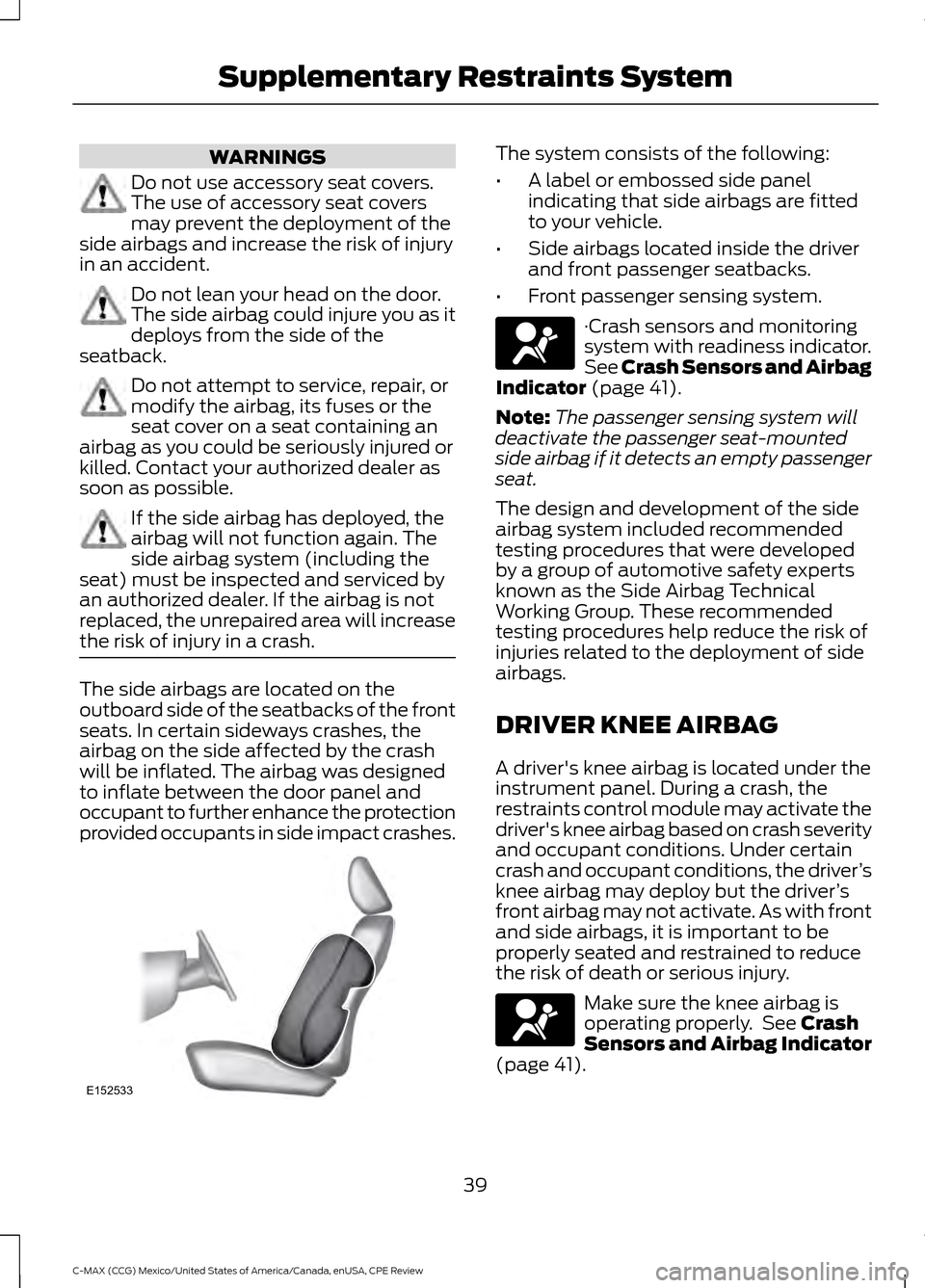
WARNINGS
Do not use accessory seat covers.
The use of accessory seat covers
may prevent the deployment of the
side airbags and increase the risk of injury
in an accident. Do not lean your head on the door.
The side airbag could injure you as it
deploys from the side of the
seatback. Do not attempt to service, repair, or
modify the airbag, its fuses or the
seat cover on a seat containing an
airbag as you could be seriously injured or
killed. Contact your authorized dealer as
soon as possible. If the side airbag has deployed, the
airbag will not function again. The
side airbag system (including the
seat) must be inspected and serviced by
an authorized dealer. If the airbag is not
replaced, the unrepaired area will increase
the risk of injury in a crash. The side airbags are located on the
outboard side of the seatbacks of the front
seats. In certain sideways crashes, the
airbag on the side affected by the crash
will be inflated. The airbag was designed
to inflate between the door panel and
occupant to further enhance the protection
provided occupants in side impact crashes. The system consists of the following:
•
A label or embossed side panel
indicating that side airbags are fitted
to your vehicle.
• Side airbags located inside the driver
and front passenger seatbacks.
• Front passenger sensing system. ·Crash sensors and monitoring
system with readiness indicator.
See Crash Sensors and Airbag
Indicator (page 41).
Note: The passenger sensing system will
deactivate the passenger seat-mounted
side airbag if it detects an empty passenger
seat.
The design and development of the side
airbag system included recommended
testing procedures that were developed
by a group of automotive safety experts
known as the Side Airbag Technical
Working Group. These recommended
testing procedures help reduce the risk of
injuries related to the deployment of side
airbags.
DRIVER KNEE AIRBAG
A driver's knee airbag is located under the
instrument panel. During a crash, the
restraints control module may activate the
driver's knee airbag based on crash severity
and occupant conditions. Under certain
crash and occupant conditions, the driver ’s
knee airbag may deploy but the driver ’s
front airbag may not activate. As with front
and side airbags, it is important to be
properly seated and restrained to reduce
the risk of death or serious injury. Make sure the knee airbag is
operating properly. See
Crash
Sensors and Airbag Indicator
(page
41).
39
C-MAX (CCG) Mexico/United States of America/Canada, enUSA, CPE Review Supplementary Restraints SystemE152533
Page 51 of 455
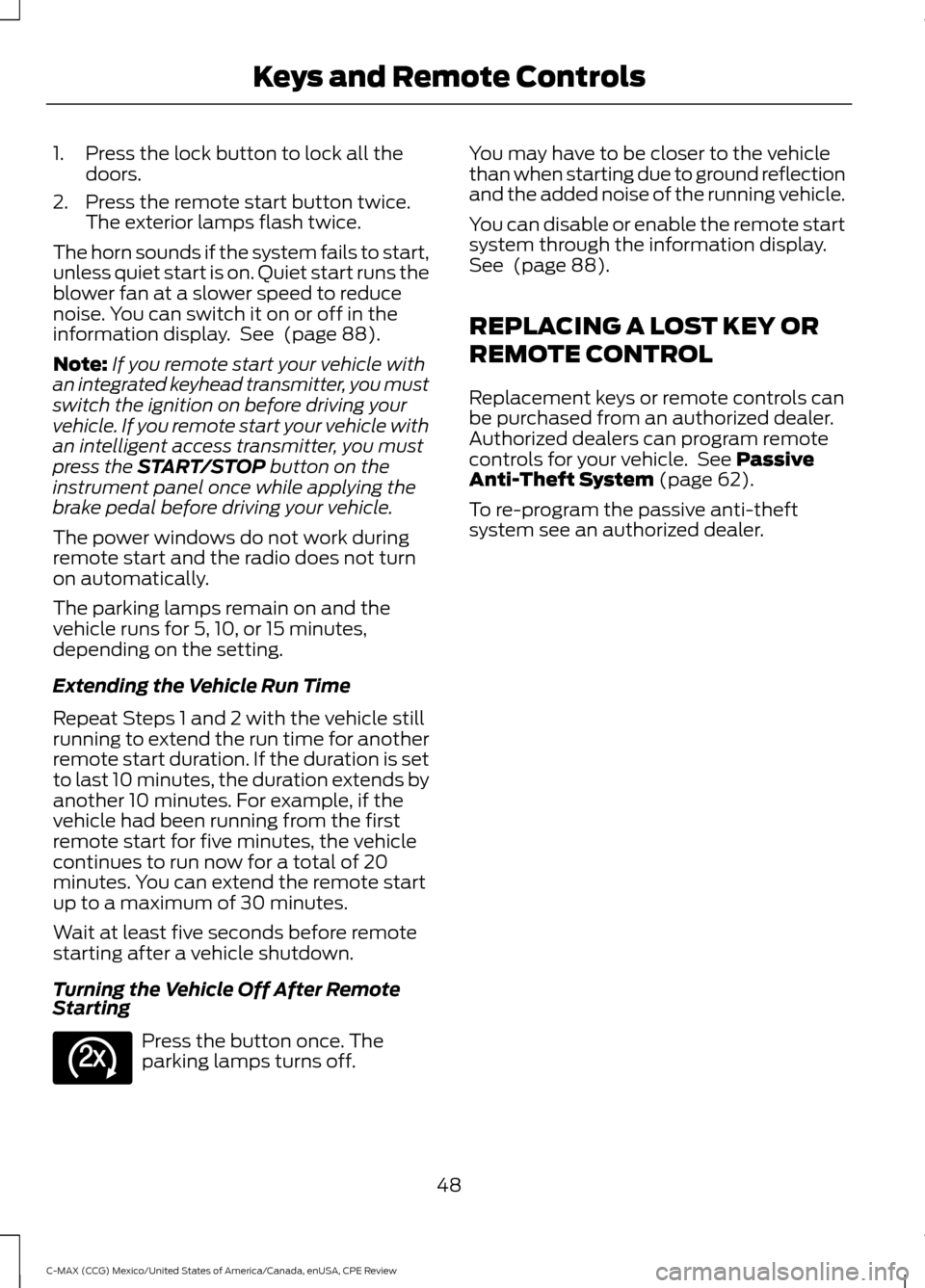
1. Press the lock button to lock all the
doors.
2. Press the remote start button twice. The exterior lamps flash twice.
The horn sounds if the system fails to start,
unless quiet start is on. Quiet start runs the
blower fan at a slower speed to reduce
noise. You can switch it on or off in the
information display. See (page 88).
Note: If you remote start your vehicle with
an integrated keyhead transmitter, you must
switch the ignition on before driving your
vehicle. If you remote start your vehicle with
an intelligent access transmitter, you must
press the
START/STOP button on the
instrument panel once while applying the
brake pedal before driving your vehicle.
The power windows do not work during
remote start and the radio does not turn
on automatically.
The parking lamps remain on and the
vehicle runs for 5, 10, or 15 minutes,
depending on the setting.
Extending the Vehicle Run Time
Repeat Steps 1 and 2 with the vehicle still
running to extend the run time for another
remote start duration. If the duration is set
to last 10 minutes, the duration extends by
another 10 minutes. For example, if the
vehicle had been running from the first
remote start for five minutes, the vehicle
continues to run now for a total of 20
minutes. You can extend the remote start
up to a maximum of 30 minutes.
Wait at least five seconds before remote
starting after a vehicle shutdown.
Turning the Vehicle Off After Remote
Starting Press the button once. The
parking lamps turns off. You may have to be closer to the vehicle
than when starting due to ground reflection
and the added noise of the running vehicle.
You can disable or enable the remote start
system through the information display.
See
(page 88).
REPLACING A LOST KEY OR
REMOTE CONTROL
Replacement keys or remote controls can
be purchased from an authorized dealer.
Authorized dealers can program remote
controls for your vehicle. See
Passive
Anti-Theft System (page 62).
To re-program the passive anti-theft
system see an authorized dealer.
48
C-MAX (CCG) Mexico/United States of America/Canada, enUSA, CPE Review Keys and Remote ControlsE138625
Page 57 of 455
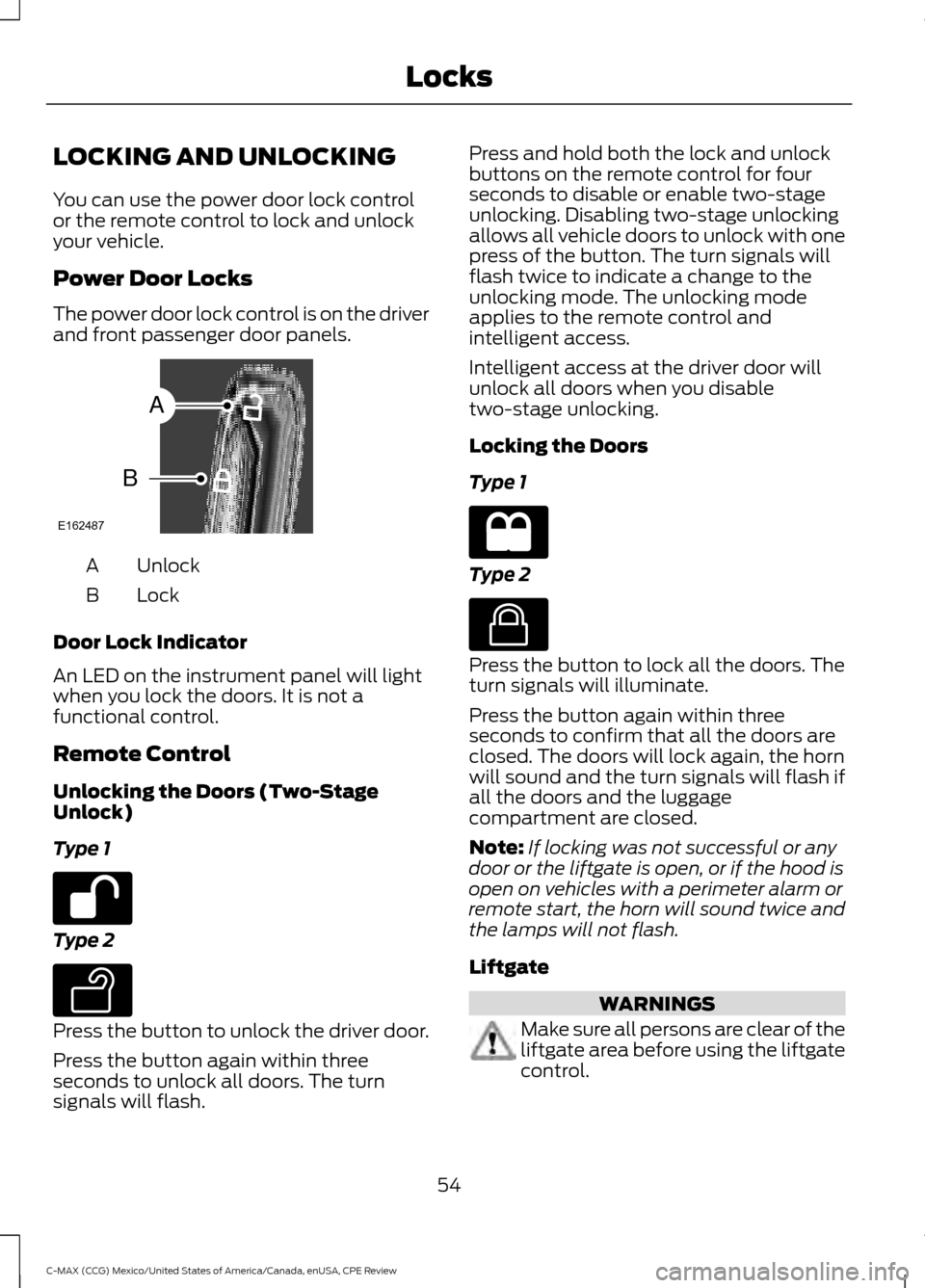
LOCKING AND UNLOCKING
You can use the power door lock control
or the remote control to lock and unlock
your vehicle.
Power Door Locks
The power door lock control is on the driver
and front passenger door panels.
Unlock
A
Lock
B
Door Lock Indicator
An LED on the instrument panel will light
when you lock the doors. It is not a
functional control.
Remote Control
Unlocking the Doors (Two-Stage
Unlock)
Type 1 Type 2
Press the button to unlock the driver door.
Press the button again within three
seconds to unlock all doors. The turn
signals will flash. Press and hold both the lock and unlock
buttons on the remote control for four
seconds to disable or enable two-stage
unlocking. Disabling two-stage unlocking
allows all vehicle doors to unlock with one
press of the button. The turn signals will
flash twice to indicate a change to the
unlocking mode. The unlocking mode
applies to the remote control and
intelligent access.
Intelligent access at the driver door will
unlock all doors when you disable
two-stage unlocking.
Locking the Doors
Type 1
Type 2
Press the button to lock all the doors. The
turn signals will illuminate.
Press the button again within three
seconds to confirm that all the doors are
closed. The doors will lock again, the horn
will sound and the turn signals will flash if
all the doors and the luggage
compartment are closed.
Note:
If locking was not successful or any
door or the liftgate is open, or if the hood is
open on vehicles with a perimeter alarm or
remote start, the horn will sound twice and
the lamps will not flash.
Liftgate WARNINGS
Make sure all persons are clear of the
liftgate area before using the liftgate
control.
54
C-MAX (CCG) Mexico/United States of America/Canada, enUSA, CPE Review LocksE162487
A
B E138629 E138623
Page 62 of 455

POWER LIFTGATE (If Equipped)
WARNINGS
It is extremely dangerous to ride in a
cargo area, inside or outside of a
vehicle. In a collision, people riding in
these areas are more likely to be seriously
injured or killed. Do not allow people to ride
in any area of your vehicle that is not
equipped with seats and safety belts. Be
sure everyone in your vehicle is in a seat
and using a safety belt properly. Make sure to close and latch the
liftgate to prevent drawing exhaust
fumes into your vehicle. This also
prevents passengers and cargo from falling
out. If you must drive with the liftgate open,
keep the vents or windows open so outside
air comes into your vehicle. Failure to
follow this warning could result in serious
personal injury. Keep keys out of reach of children.
Do not allow children to play near an
open or moving power liftgate.
Note:
Cycling the ignition while the liftgate
is power closing and is near the latch may
cause the liftgate to reverse to full open
position. Make sure that you close the
liftgate before operating or moving the
vehicle, especially in an enclosure, like a
garage or a parking structure. You could
damage the liftgate or its components.
Note: Do not hang anything, for example a
bike rack, from the spoiler, glass or liftgate.
This could damage the liftgate and its
components.
If the vehicle is running, the liftgate only
operates with the transmission in park.
One warning tone sounds as the liftgate
begins to power close. Three short chimes
indicate a problem with the open or close
request, caused by: •
The ignition is on and the transmission
is not in P.
• The battery voltage is below the
minimum operating voltage.
• The vehicle speed is at or above 3 mph
(5 km/h).
If the liftgate falls to the closed direction
after the liftgate has stopped in the open
position, ten short warning chimes indicate
excessive weight on the gate or a possible
gas strut failure. Have the system checked
by an authorized dealer if you still have the
issue after you remove the load.
Opening and Closing the Liftgate WARNING
Make sure all persons are clear of the
power liftgate area before using the
power liftgate control.
Note:
Be careful when opening or closing
the liftgate in a garage or other enclosed
area to avoid damaging the liftgate.
Note: Do not leave the liftgate open while
driving. This could damage the liftgate and
its components.
Note: You can stop the liftgate movement
direction with a second press of the
instrument panel button or the control
button on the liftgate, a double press of the
transmitter button, or by using a kicking
motion with your foot for hands-free
liftgates.
From the Instrument Panel Press the instrument panel
button.
With the Remote Control Press the remote control button
twice within three seconds.
59
C-MAX (CCG) Mexico/United States of America/Canada, enUSA, CPE Review LocksE138633 E138630
Page 73 of 455
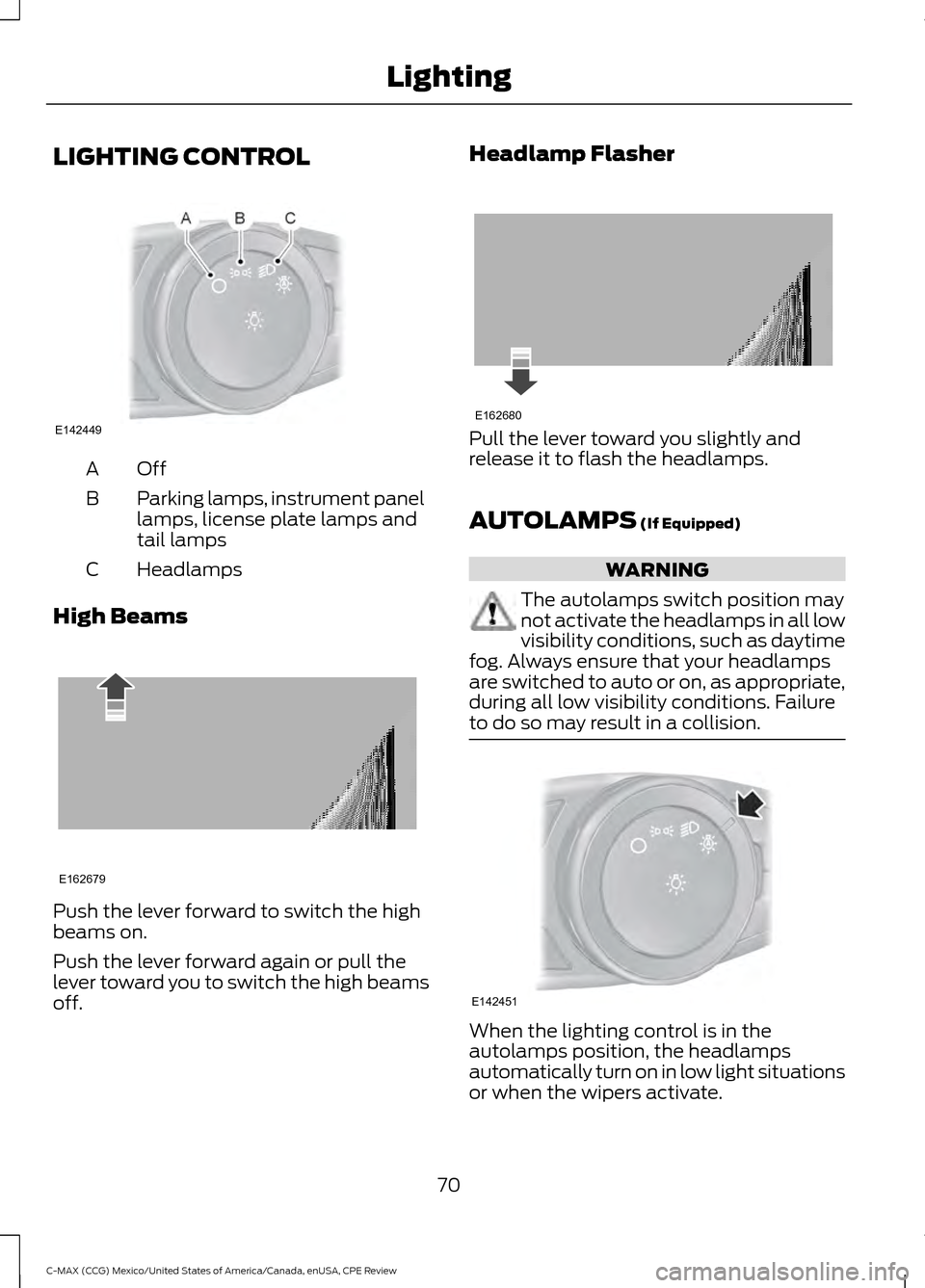
LIGHTING CONTROL
OffA
Parking lamps, instrument panel
lamps, license plate lamps and
tail lamps
B
Headlamps
C
High Beams Push the lever forward to switch the high
beams on.
Push the lever forward again or pull the
lever toward you to switch the high beams
off. Headlamp Flasher
Pull the lever toward you slightly and
release it to flash the headlamps.
AUTOLAMPS (If Equipped)
WARNING
The autolamps switch position may
not activate the headlamps in all low
visibility conditions, such as daytime
fog. Always ensure that your headlamps
are switched to auto or on, as appropriate,
during all low visibility conditions. Failure
to do so may result in a collision. When the lighting control is in the
autolamps position, the headlamps
automatically turn on in low light situations
or when the wipers activate.
70
C-MAX (CCG) Mexico/United States of America/Canada, enUSA, CPE Review LightingE142449 E162679 E162680 E142451
Page 107 of 455
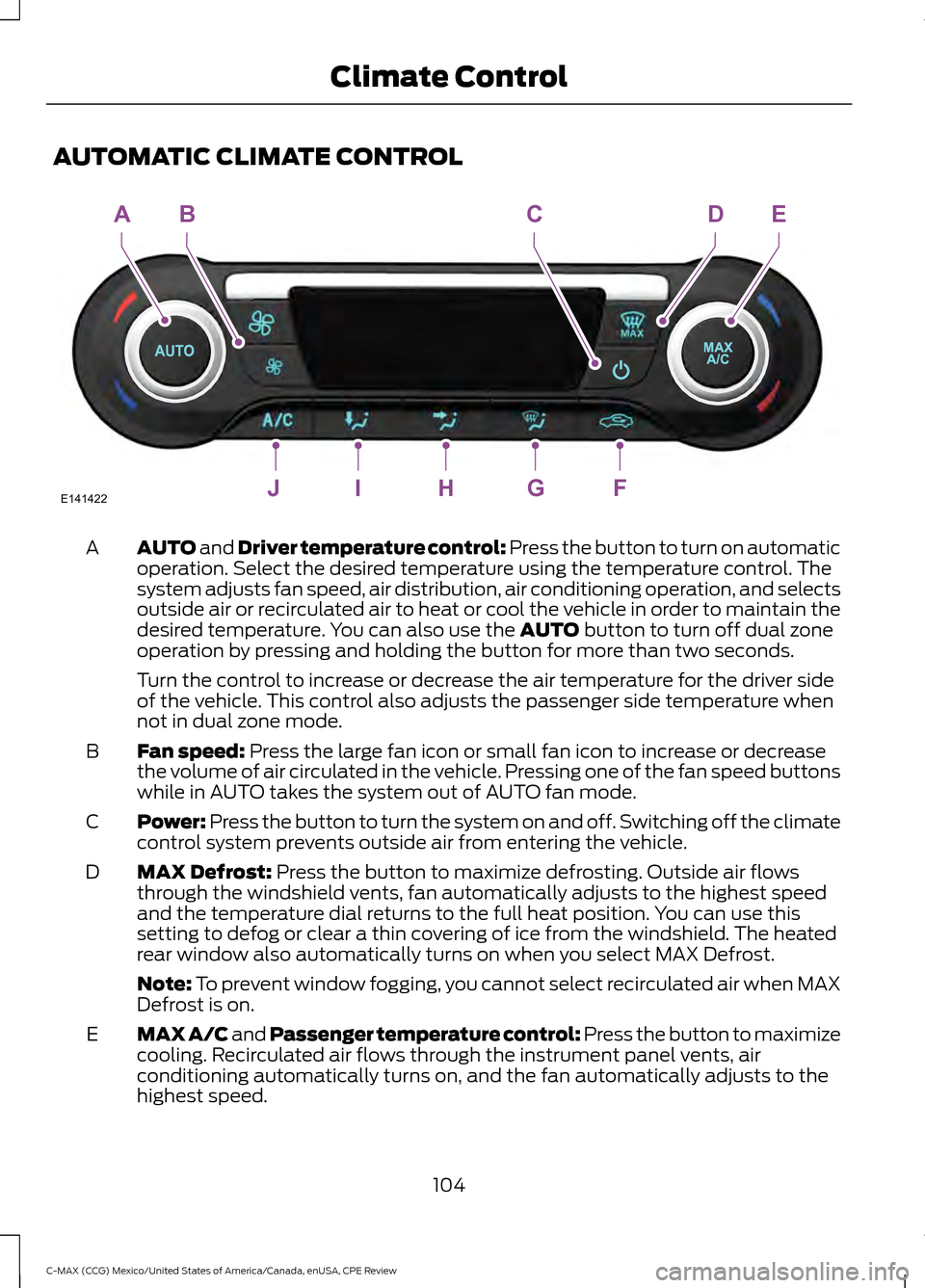
AUTOMATIC CLIMATE CONTROL
AUTO and Driver temperature control: Press the button to turn on automatic
operation. Select the desired temperature using the temperature control. The
system adjusts fan speed, air distribution, air conditioning operation, and selects
outside air or recirculated air to heat or cool the vehicle in order to maintain the
desired temperature. You can also use the
AUTO button to turn off dual zone
operation by pressing and holding the button for more than two seconds.
A
Turn the control to increase or decrease the air temperature for the driver side
of the vehicle. This control also adjusts the passenger side temperature when
not in dual zone mode.
Fan speed:
Press the large fan icon or small fan icon to increase or decrease
the volume of air circulated in the vehicle. Pressing one of the fan speed buttons
while in AUTO takes the system out of AUTO fan mode.
B
Power: Press the button to turn the system on and off. Switching off the climate
control system prevents outside air from entering the vehicle.
C
MAX Defrost:
Press the button to maximize defrosting. Outside air flows
through the windshield vents, fan automatically adjusts to the highest speed
and the temperature dial returns to the full heat position. You can use this
setting to defog or clear a thin covering of ice from the windshield. The heated
rear window also automatically turns on when you select MAX Defrost.
D
Note:
To prevent window fogging, you cannot select recirculated air when MAX
Defrost is on.
MAX A/C and Passenger temperature control: Press the button to maximize
cooling. Recirculated air flows through the instrument panel vents, air
conditioning automatically turns on, and the fan automatically adjusts to the
highest speed.
E
104
C-MAX (CCG) Mexico/United States of America/Canada, enUSA, CPE Review Climate ControlE141422JIHGF
ABCDE
Page 108 of 455

Turn the control to increase or decrease the air temperature on the passenger
side of the vehicle. This turns on dual zone mode.
Recirculated air: Press the button to switch between outside air and
recirculated air. When you select recirculated air, the air currently in the
passenger compartment recirculates. This may reduce the time needed to cool
the interior (when used with
A/C) and may reduce unwanted odors from
entering your vehicle.
F
Note:
Recirculated air may turn off automatically (or be prevented from turning
on) in all airflow modes except MAX A/C to reduce risk of fogging. Recirculated
air may also turn on and off automatically in Panel or Panel and Floor airflow
modes during hot weather in order to improve cooling efficiency.
Defrost: Press the button to distribute air to the windshield vents and de-mister.
Air distribution to instrument panel and footwell vents turn off. You can use
this setting to defog and clear the windshield of a thin covering of ice.
G
Instrument panel:
Press to distribute air through the instrument panel vents.
Press again to turn off panel mode.
H
Floor:
Distributes air through the demister vents and front and rear seat floor
vents. Press again to turn off floor mode.
I
A/C:
Press the button to turn air conditioning compressor on or off. Use air
conditioning with recirculated air to improve cooling performance and efficiency.
J
Note:
In certain conditions (such as when using Max Defrost), the air
conditioning compressor may continue to operate even after you switch off the
air conditioning with the
A/C button.
Temperature Control You can set the temperature between
60°F (15.5°C) and 85°F (29.5°C) in steps
of 1°F (0.5°C). In position LO, 59°F (15°C),
the system switches to permanent cooling.
In position
HI, 86°F (30°C), the system
switches to permanent heating. Single Zone Temperature Control
In this mode, the climate control system
links the temperature settings for both the
driver's side and passenger's side. If you
adjust the setting using the rotary control
on the driver
’s side, the system adjusts the
temperature to the same setting on the
passenger ’s side.
105
C-MAX (CCG) Mexico/United States of America/Canada, enUSA, CPE Review Climate ControlE133115
Page 109 of 455
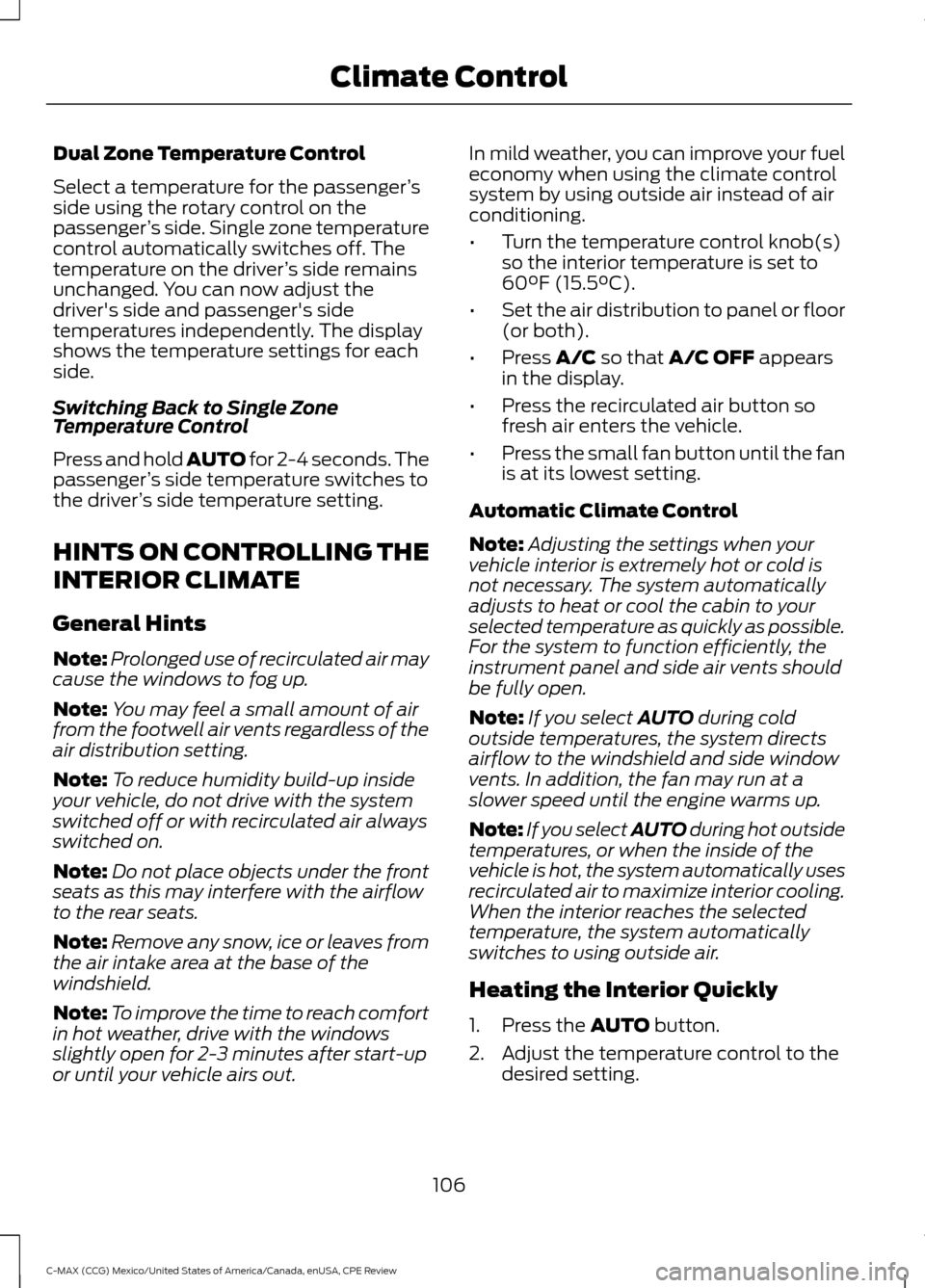
Dual Zone Temperature Control
Select a temperature for the passenger
’s
side using the rotary control on the
passenger ’s side. Single zone temperature
control automatically switches off. The
temperature on the driver ’s side remains
unchanged. You can now adjust the
driver's side and passenger's side
temperatures independently. The display
shows the temperature settings for each
side.
Switching Back to Single Zone
Temperature Control
Press and hold AUTO for 2-4 seconds. The
passenger ’s side temperature switches to
the driver ’s side temperature setting.
HINTS ON CONTROLLING THE
INTERIOR CLIMATE
General Hints
Note: Prolonged use of recirculated air may
cause the windows to fog up.
Note: You may feel a small amount of air
from the footwell air vents regardless of the
air distribution setting.
Note: To reduce humidity build-up inside
your vehicle, do not drive with the system
switched off or with recirculated air always
switched on.
Note: Do not place objects under the front
seats as this may interfere with the airflow
to the rear seats.
Note: Remove any snow, ice or leaves from
the air intake area at the base of the
windshield.
Note: To improve the time to reach comfort
in hot weather, drive with the windows
slightly open for 2-3 minutes after start-up
or until your vehicle airs out. In mild weather, you can improve your fuel
economy when using the climate control
system by using outside air instead of air
conditioning.
•
Turn the temperature control knob(s)
so the interior temperature is set to
60°F (15.5°C).
• Set the air distribution to panel or floor
(or both).
• Press
A/C so that A/C OFF appears
in the display.
• Press the recirculated air button so
fresh air enters the vehicle.
• Press the small fan button until the fan
is at its lowest setting.
Automatic Climate Control
Note: Adjusting the settings when your
vehicle interior is extremely hot or cold is
not necessary. The system automatically
adjusts to heat or cool the cabin to your
selected temperature as quickly as possible.
For the system to function efficiently, the
instrument panel and side air vents should
be fully open.
Note: If you select
AUTO during cold
outside temperatures, the system directs
airflow to the windshield and side window
vents. In addition, the fan may run at a
slower speed until the engine warms up.
Note: If you select AUTO during hot outside
temperatures, or when the inside of the
vehicle is hot, the system automatically uses
recirculated air to maximize interior cooling.
When the interior reaches the selected
temperature, the system automatically
switches to using outside air.
Heating the Interior Quickly
1. Press the
AUTO button.
2. Adjust the temperature control to the desired setting.
106
C-MAX (CCG) Mexico/United States of America/Canada, enUSA, CPE Review Climate Control